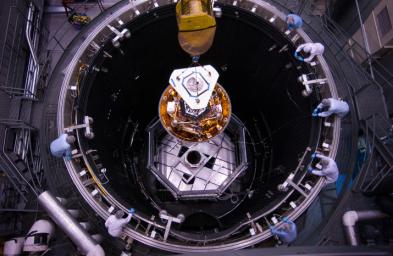
|
Phoenix Lowered into Thermal Vacuum Chamber
- Click the image above for a larger view
- Full-Res JPEG (2000 x 1303) (462.2 kB)
- Full-Res TIFF (2000 x 1303) (7.8 MB)
Caption:
NASA's Phoenix Mars Lander was lowered into a thermal vacuum chamber at Lockheed Martin Space Systems, Denver, in December 2006.
The spacecraft was folded in its aeroshell and underwent environmental testing that simulated the extreme conditions the spacecraft will see during its nine-and-a-half-month cruse to Mars.
Background Info:
The Phoenix mission is led by Principal Investigator Peter H. Smith of the University of Arizona, Tucson, with project management at NASA's Jet Propulsion Laboratory and development partnership with Lockheed Martin Space Systems. International contributions for Phoenix are provided by the Canadian Space Agency, the University of Neuchatel (Switzerland), the University of Copenhagen, and the Max Planck Institute in Germany. JPL is a division of the California Institute of Technology in Pasadena.
Photojournal Note: As planned, the Phoenix lander, which landed May 25, 2008 23:53 UTC, ended communications in November 2008, about six months after landing, when its solar panels ceased operating in the dark Martian winter.
Cataloging Keywords:
| Name | Value | Additional Values |
|---|---|---|
| Target | Mars | |
| System | ||
| Target Type | Planet | |
| Mission | Phoenix | |
| Instrument Host | Phoenix Lander | |
| Host Type | Lander | |
| Instrument | ||
| Detector | ||
| Extra Keywords | Color, Thermal | |
| Acquisition Date | ||
| Release Date | 2007-02-28 | |
| Date in Caption | ||
| Image Credit | NASA/JPL/UA/Lockheed Martin | |
| Source | photojournal.jpl.nasa.gov/catalog/PIA09205 | |
| Identifier | PIA09205 | |
